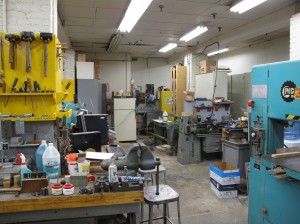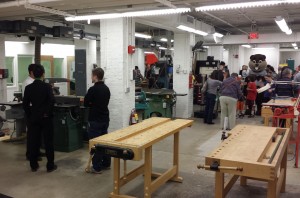More Makerspace! Hobby Shop Reopens for its 75th Birthday
-
-
slice.mit.edu
Filed Under
Recommended
Long a refuge for the imaginative and industrious with precious little time on their hands, the shop and its equipment, over time, became the worse for wear.


Ken Stone ’72, the shop’s fourth director in its 75-year history, advocated for a grand birthday present for the shop, and this summer, he got his wish. Over the weekend, the newly renovated Hobby Shop reopened, and the makers on campus, be they students, alumni, or staff, got right back to work.
The weekend events featured an open house on Friday afternoon, where MIT Chaplain Robert Randolph led a rededication of the shop. A reception for those who had helped contribute over $100,000 to the renovations followed in the Stratton Center, where Provost Chris Kaiser and Professors Sam Allen and Alex Slocum spoke of the shop’s essential service to the Institute and the tinkering and ingenuity that the next generation of its members will invest in it.
What has changed? The interior walls of the shop were taken down to widen the space. The tile ceiling was removed, and new sprinklers, fire alarms, and HVAC make it a safer and more comfortable space. New MIG and TIG welders have been installed, and a new computer room adjacent to the shop allows for computer aided design space.
On Saturday, shop members and sponsors worked side by side at the machines to build commemorative, personalized mementos, while Bob Simha ’57, head of the MIT Planning Office, led tours.
Hobbyist and club president Folkers Rojas '09, SM '11 caught the Hobby Shop bug early in his MIT career and decided against pursuing his PhD at UC-Berkeley because their shop, he found upon visiting, was strictly for research purposes. "It made my decision to [stay at] MIT a lot easier," he said, "and I have no regrets."
Without the shop and its mentoring model for students of all levels, Rojas believes the Institute motto, mens et manus, would mean little. "You could lose your mind [here] if you don't use your hands," Rojas says. "This provides a sanity break. For me it's about bringing ideas to life."
“Now we have opportunity to make it the first class 21st century maker space MIT students deserve,” says shop director Ken Stone ’72. “Our renovation will give us an expanded space with air conditioning, computer lab, and ventilation for welding and laser cutting.”
The shop, as Stone’s eloquent history relates, opened in the basement of Building 2 in 1938 as one of many spaces on campus for projects unrelated to classwork. As more hobby club spaces and their machines became essential for coursework, however, the Hobby Shop, relocated in the 1970s to W31, became a last refuge for those needing to channel some alternative energies into experimentation and fun.
The Hobby Shop has nurtured great creative minds of the past 75 years, such as Chuck Jordan '49 and Rodney Regier '72. Stone is just as proud of the shop’s new members, those who still find, in the digital 21st century, value in the very real, physical process of making things with their own hands.
“The shop provides a place for any MIT student, regardless of major or experience, to work with a wide range of well-maintained machines and tools and to receive instruction, as well as practical design and building advice,” he says.







